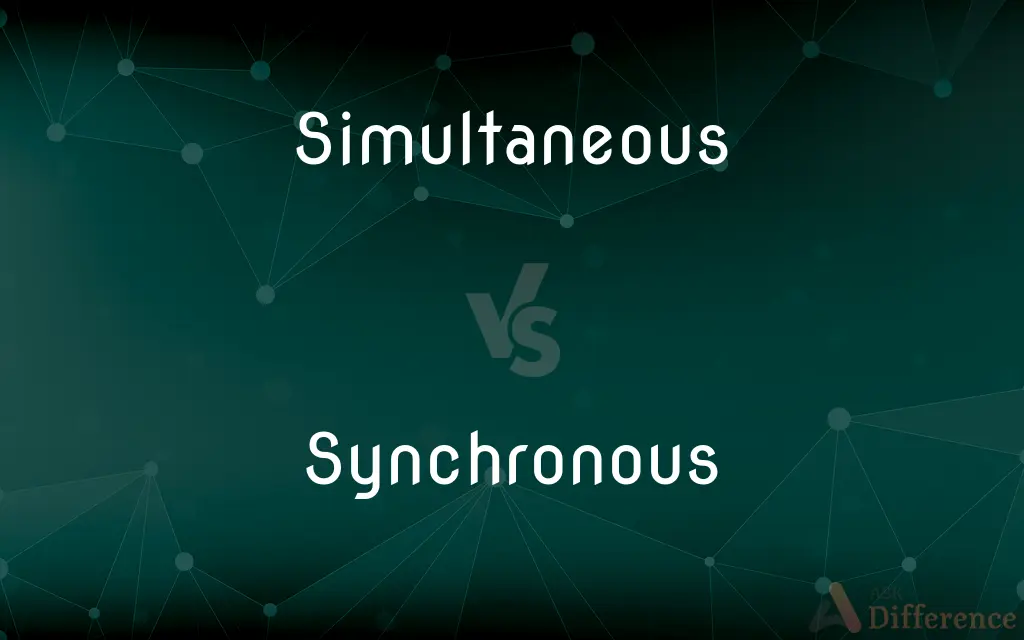Simultaneous vs. Synchronous — What's the Difference?
Edited by Tayyaba Rehman — By Fiza Rafique — Updated on March 14, 2024
Simultaneous events occur at the same time, while synchronous ones are in unison over time.

Difference Between Simultaneous and Synchronous
Table of Contents
ADVERTISEMENT
Key Differences
Simultaneous events happen at the same moment but are independent of each other, not requiring any coordination or alignment over a sequence of events. It's about the coincidence in timing rather than a pattern or order. Whereas, synchronous activities or processes are not only occurring at the same time but are also aligned or coordinated in a sequence, maintaining a consistent pace or rhythm relative to each other over a period.
While simultaneity is a single instance of two or more events happening at once, synchrony involves a repeated, consistent timing pattern between processes or events. Simultaneous occurrences can be random and one-off, on the other hand, synchronous ones imply a regularity or a system where things are designed or happen to work together in harmony over time.
For example, two fireworks exploding at the same instant are simultaneous; clocks ticking in unison are synchronous. The first is a single moment of coincidence, while the latter suggests an ongoing relationship in timing.
Synchronous interactions are often critical in systems where timing precision is essential, such as in data transfer in telecommunications, where signals or data packets are sent in a timed order. Simultaneous actions, however, might be more relevant in contexts where the timing overlap is incidental, such as two people accidentally speaking at the same moment during a conversation.
The concept of simultaneity is simpler, focusing solely on the aspect of concurrent timing, while synchrony introduces the complexity of ongoing coordination or alignment, making it crucial in more complex systems or performances, such as in music, dance, or the functioning of an engine.
ADVERTISEMENT
Comparison Chart
Definition
Occurring at the same time
Operating in unison over time
Coordination
Independent events
Coordinated or aligned events
Regularity
One-off occurrences
Repeated pattern or sequence
Example
Two light bulbs turning on at once
Dancers moving to the same beat
Context
Coincidental timing
Precision and harmony in timing
Compare with Definitions
Simultaneous
Occurring at the same time.
The simultaneous ringing of all the phones in the office created a cacophony.
Synchronous
Operating at the same rate and exactly together.
The synchronous movement of the clock hands was mesmerizing.
Simultaneous
Happening coincidentally together.
Their simultaneous laughter broke the tension in the room.
Synchronous
In unison over a period.
The synchronous flashing of fireflies lit up the night.
Simultaneous
Concurrent events without coordination.
The simultaneous arrival of two guests caused a brief confusion.
Synchronous
Aligned in time or sequence.
The dancers' synchronous steps were a testament to their practice.
Simultaneous
One-off overlap in timing.
The simultaneous eclipse and sunset offered a rare spectacle.
Synchronous
Coordinated in timing.
The team worked in synchronous harmony to complete the project efficiently.
Simultaneous
Independent but concurrent actions.
The team executed their tasks simultaneously to meet the deadline.
Synchronous
Consistently timed interactions.
The synchronous orbits of the Earth and the moon result in regular eclipses.
Simultaneous
Happening, existing, or done at the same time.
Synchronous
Occurring or existing at the same time.
Simultaneous
(Mathematics) Containing variables for which there are values that can satisfy all the equations
Simultaneous equations.
Synchronous
Moving or operating at the same rate
Synchronous motors.
Simultaneous
Happening at the same moment.
Synchronous
Having identical periods.
Simultaneous
To be solved for the same values of variables.
Synchronous
Having identical period and phase
Synchronous oscillations.
Simultaneous
Existing, happening, or done, at the same time; as, simultaneous events.
Synchronous
Relating to or being a satellite that orbits a celestial body at a speed that matches the body's rotation, thus remaining stationary as observed from the body's surface.
Simultaneous
Occurring or operating at the same time;
A series of coincident events
Synchronous
Synchronized by an electronic clock
Synchronous signaling.
Synchronous
At the same time, at the same frequency.
Synchronous
Single-threaded; blocking; occurring in the same thread as other computations, thereby preventing those computations from resuming until the communication is complete.
Synchronous
Happening at the same time; simultaneous.
Synchronous
Occurring or existing at the same time or having the same period or phase;
Recovery was synchronous with therapy
A synchronous set of clocks
The synchronous action of a bird's wings in flight
Synchronous oscillations
Synchronous
(digital communication) pertaining to a transmission technique that requires a common clock signal (a timing reference) between the communicating devices in order to coordinate their transmissions
Common Curiosities
What defines synchronous events?
Synchronous events are not only happening at the same time but are also coordinated or aligned in their timing, showing a pattern or sequence.
Are simultaneous events related to each other?
Simultaneous events might not be related; their main connection is the coincidence in timing.
Why is synchrony important in technology?
In technology, synchrony ensures that processes, data transfers, and communications are timely and orderly, reducing errors and improving performance.
What does simultaneous mean?
Simultaneous refers to events or actions occurring at the same time but independently of each other.
Can events be both simultaneous and synchronous?
Yes, events can be both if they occur at the same time and are part of a coordinated sequence or pattern.
Can simultaneous events become synchronous?
Yes, if simultaneous events start to occur in a regular, coordinated pattern, they can become synchronous.
How does synchrony affect a system?
Synchrony ensures harmony and efficiency in systems, as seen in synchronized swimming, clock mechanisms, or data transmission.
What role does synchrony play in nature?
Synchrony in nature, such as in the mating rituals of certain species or the growth cycles of plants, often leads to ecological balance and harmony.
How do musicians achieve synchrony?
Musicians achieve synchrony through practice, timing, and coordination, ensuring their performances are harmonized.
Is simultaneity common in everyday life?
Yes, simultaneous events are common in daily life, such as multitasking or coincidental occurrences, without necessarily being synchronized.
Share Your Discovery

Previous Comparison
Reimbursement vs. Indemnity
Next Comparison
Honor vs. PrideAuthor Spotlight
Written by
Fiza RafiqueFiza Rafique is a skilled content writer at AskDifference.com, where she meticulously refines and enhances written pieces. Drawing from her vast editorial expertise, Fiza ensures clarity, accuracy, and precision in every article. Passionate about language, she continually seeks to elevate the quality of content for readers worldwide.
Edited by
Tayyaba RehmanTayyaba Rehman is a distinguished writer, currently serving as a primary contributor to askdifference.com. As a researcher in semantics and etymology, Tayyaba's passion for the complexity of languages and their distinctions has found a perfect home on the platform. Tayyaba delves into the intricacies of language, distinguishing between commonly confused words and phrases, thereby providing clarity for readers worldwide.
















































